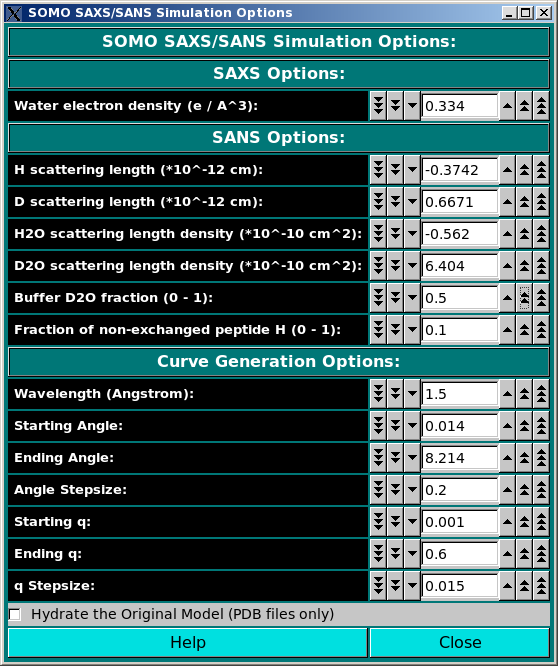
 |
Manual |

In this module you can set/change the parameters used by the SAXS/SANS Simulation Module.
In the SAXS Options: section, currently there is only one parameter that can be set/changed, the Water electron density (e / A^3): (default: 0.334 e/A3).
In the SANS Options: section, several parameters can be controlled. The hydrogen and deuterium neutron
scattering lengths can be set in the H scattering length (*10^-12 cm): (default: -0.3742 x 10-12 cm)
and D scattering length (*10^-12 cm): (default: 0.6671 x 10-12 cm) fields, respectively.
Likewise, the H2O and D2O neutron scattering lengths densities can be set in the
H2O scattering length density (*10^-10 cm^2): (default: -0.562 x 10-10 cm2)
and D2O scattering length density (*10^-10 cm^2): (default: 6.404 x 10-10 cm2) fields, respectively.
The actual D2O content in the sample is set in the Buffer D2O fraction (0 - 1): field
(default: 0.5), and the fraction of non-exchanged peptide hydrogen can be controlled in the
Fraction of non-exchanged peptide H (0 - 1): field (default: 0.1).
The actual scattering length b at the set D2O fraction Y, b(Y), for each atom i, b(Y)i, is then computed by the program using this equation:
b(Y)i = b(0)i + n(HExch)i * Y * [b(D) - b(H)] * [ 1- f(NHExch)i]
where b(0)i are the neutron scattering lengths of the non-H atoms at Y = 0 and n(HExch)i are the number of exchangeable H attached to them (both tabulated in the hybridization table), b(D) and b(H) are the D and H scattering lengths, respectively, and f(NHNExch)i is the fraction of non-exchanged peptide bond H (which is 0 for all atoms except for the peptide bond N atom), all as defined in the SAXS/SANS Simulation Options: panel (see above).
The Curve Generation Options: section contains fields whose values are used in the simulation of either a
SAXS or a SANS curve.
Enter either the X-ray or neutron wavelength in the Wavelength (Angstrom): field (default: 1.5 A for
SAXS; for SANS, an usual value is 6 A).
The span and point density of the simulated curve can be controlled by entering appropriate values in the
Starting Angle, Ending Angle, and Angle Stepsize fields, or in the
corresponding Starting q, Ending q, and q Stepsize fields, where the
transformation from angle units to scattering vector q units is automatically carried over by the program.
Default values are 0.001 to 0.6 A-1 q range with a 0.015 stepsize, corresponding to an
angular range of 0.014 to 8.214 degrees with a 0.2 degrees stepsize for a wavelength of 1.5 A.
The Hydrate the Original Model (PDB files only) checkbox is instead currently (January 2010) inactive. In the future, it should allow the addition of the theoretically-bound water of hydration in specific locations at the surface of the atomic structure under study, for a better evaluation of the SAXS curves.
This document is part of the UltraScan Software Documentation
distribution.
Copyright © notice.
The latest version of this document can always be found at:
http://www.ultrascan.uthscsa.edu
Last modified on February 26, 2010.